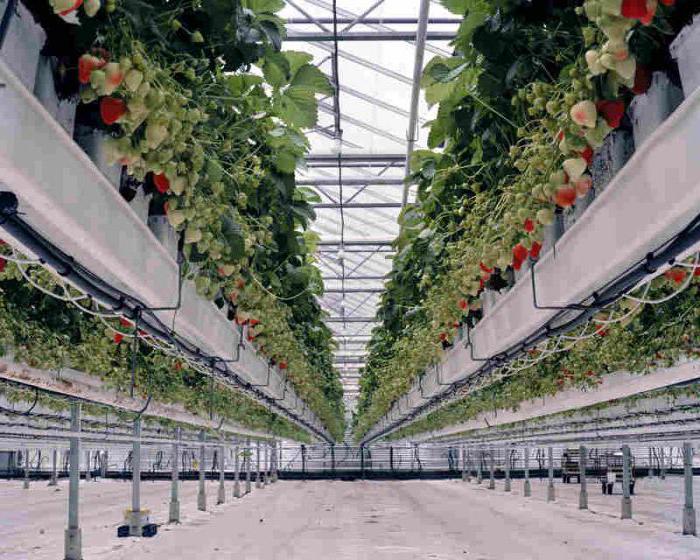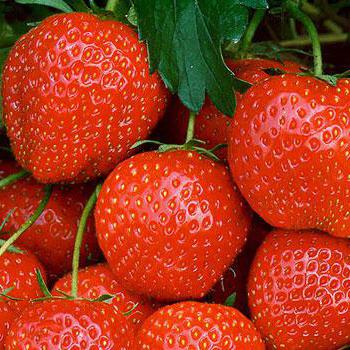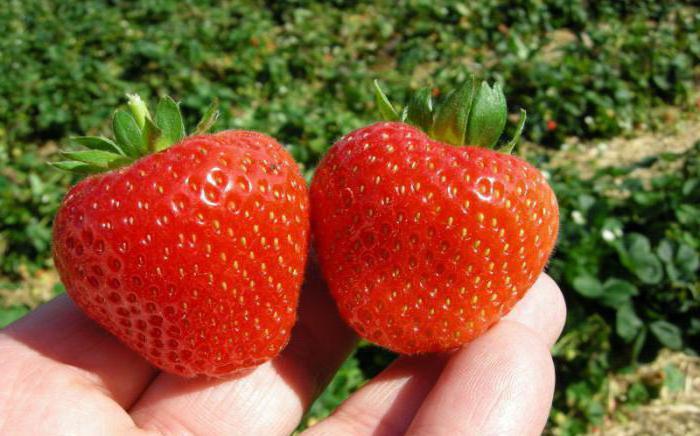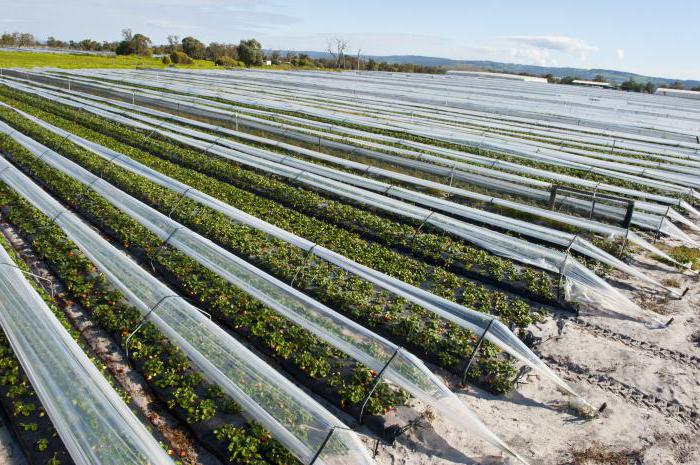Strawberry is the most popular berry, as it appears on our table first among garden crops. But summer passes quickly, and you always want berries, especially in winter. Breeders have bred varieties that grow and produce high yields of delicious berries all winter. How is the industrial cultivation of strawberries in the greenhouse all year round? What varieties are suitable for this, read the article.
Growing strawberries
Different methods of growing strawberries are chosen depending on production capacities and economic opportunities. Dutch technology is very popular. How it works? The cultivation of strawberries in an industrial way is carried out thanks to the continuous planting of seedlings throughout the year, regardless of the season. After a month and a half, when the harvest is over, the plants are thrown away, new ones are planted in their place.
In order for the fruiting of strawberries to be quick, the plant bushes receive special nutrition, which enters them through pipelines. The drip method of fluid supply is used.

Following this technology, plants in a greenhouse can be placed vertically in pots or horizontally on racks. For comfortable growth, they need to provide decent content:
- Normal lighting. If it is not enough, additional light sources are installed. Approximate calculation: for six meters of square area, you need only one bulb for sixty watts. If you increase the daylight hours to twelve to sixteen hours, the strawberries will bloom in ten days.
- Watering using a drip system. It should be carried out regularly and stably.
- The optimum humidity in the greenhouse is not higher than eighty degrees. This is achieved through regular top watering. Procedures are stopped during the flowering period, since water entering the vegetative part of plants leads to fungal diseases.
- If there is no ventilation system in the greenhouse, the room must be ventilated. Carbon dioxide level control is carried out by special sensors.
- It is necessary to constantly maintain the temperature regime. Before flowering, eighteen to twenty-one degrees is enough, when the first flowers appear - twenty-eight.
- If necessary, artificial pollination of plants is carried out.
Planting strawberries in a greenhouse is carried out in the same way as in open ground. Planting material is seedlings obtained by rooting mustaches, and seedlings grown from seeds. Industrial cultivation of strawberries is carried out by seedlings purchased in specialized stores or nurseries.
Varieties of strawberries for industrial cultivation
There are a huge variety of varieties and hybrids of strawberries. But for industrial cultivation in the greenhouse conditions of the Far East, Siberia and the Urals, repair varieties are better suited. For them, it is not necessary to create artificial pollination, since these are self-pollinated varieties. Removable strawberries ripen early, which ensures a good harvest even with thickened bushes.
This strawberry belongs to the group of plants with a neutral daylight, so in the greenhouse there is no need to install additional lighting. There are many repair varieties, some of which are presented below.
Elsanta
This strawberry variety is popular and grown everywhere in open ground and in greenhouses. The value lies in the high quality of the berries, attractive appearance.The fruits are well transported, stored for a long time without compromising quality even at room temperature.

This is a dessert variety of Dutch selection. Berries are large and bright red with a shiny surface. They have the shape of a wide cone and amazing taste. The disadvantage of this variety is susceptibility to fungal diseases and low frost resistance. In order for the plants to survive until spring, they need to be covered for the winter.
Honey
This strawberry variety has a high yield. If it is planned to grow strawberries on an industrial scale, Honey is ideal for greenhouses and open ground, as it has good transportability. The berries of this variety are large, with dense skin and dark red color, have a piquant taste with acidity and a glossy gloss on the surface. Harvested when the berries are fully ripe.
This strawberry variety is disease resistant. He is not afraid of temperature extremes, heavy rains and frosts, if grown outdoors. Strawberries grow even on soils with excessive calcium.
Albion
Growing strawberries in industrial greenhouses for business is recommended to start with this repairing variety, which gardeners love. After all, this strawberry has the longest fruiting time. Berries have excellent taste and excellent presentation. They are transported without loss of quality.

Large, elongated berries have an attractive cone shape. They are consumed fresh and processed: they make jams, jams. Strawberries are resistant to late blight, verticillosis and other diseases. Resistant to adverse weather conditions.
Portola
This variety of strawberry remover from America is new. But he managed to prove himself in the best way, especially for those who plan to begin industrial cultivation of strawberries in a greenhouse all year round. Portola is a continuation of the variety with a good reputation - Albion. But the new variety yields thirty percent higher than its predecessor.
The berries are very large, heavy, their mass reaches thirty grams or more. They differ in expressive form, in the form of a wide cone. The pulp is firm, without crunching. Very pleasant, harmonious taste.

The disadvantage of the variety is poor resistance against a disease such as brown spotting. Therefore, prophylactic treatments with fungicides, such as Quadris, should be regularly carried out.
Monterey
This is a remodeled strawberry variety from California. It is a continuation of Albion, only its yield is twenty-five percent higher. Monterey's industrial strawberry cultivation is a good choice for a successful business. Especially for the autumn-winter and spring periods. The berries are large in size, the flesh - juiciness and sweet taste.
Industrial greenhouses
In order to get tasty and healthy berries for a long time, they are grown in greenhouses, which are of two types:
- Seasonal They are more popular, as their construction requires small investments. In such greenhouses, cultivated plants of vegetable gardens and gardens are grown from March to November, that is, until the time when it is not necessary to heat the room.
- Year-round. For the construction of such greenhouses, large investments are needed. This is due to the construction of premises for equipment. Such buildings are highly profitable, since they grow vegetables and fruits year-round.
Greenhouses for growing strawberries on an industrial scale differ in many other ways. So, a glass coating is used for seasonal greenhouses, since a strong frame is required for its installation.

Polycarbonate acquired great popularity as a coating material. It is easy to install, has great durability, high thermal insulation properties and transmits light well.It tolerates temperature changes and is easily transported, while not being deformed.
The beds in greenhouses are equipped in the ground, on shelves (horizontally) or in hanging bags (vertically). The frame of greenhouses can be wooden, metal or polymer. The choice of a greenhouse depends, first of all, on financial opportunities and production facilities.
Open strawberries
The industrial cultivation of strawberries in the open field is simple and has a good economic benefit. This is achieved due to the fact that strawberries grow on soils with different particle size distributions.
So that productivity is high, the soil is filled with fertilizers, green manure and perennial herbs. Dry areas, moist with a large amount of stagnant water and marshy, are unsuitable for the growth of strawberries. Surface occurrence of groundwater is undesirable.

Industrial cultivation of strawberries is carried out on flat areas or gentle slopes. If you determine for her low places, she may suffer from frost. Near the site should be a natural or artificial pond.
Ridges with strawberries are surrounded on all sides by tree stands. They are planted in quarters, an area of 4x10 hectares, which are divided by internal roads with a width of three to four meters. Rows for planting strawberries should be at least one hundred meters wide.
Crop rotation
Industrial cultivation of strawberries involves such an agrotechnical measure as the design of crop rotation. Growing in one place, high yields of strawberries gives three to four years. Then it weakly resists frosts, is more often affected by diseases, its berries are smaller. As a result, productivity decreases.
The crop rotation of each farm is made taking into account production conditions and economic opportunities. An example of a seven-field crop rotation for the Black Earth regions of Russia:
- On the first field, strawberries are planted.
- On the second, third, fourth - fruiting strawberries grow, it gives good harvests.
- On the fifth plot, where strawberries grew, oats or rye are planted to prepare green mass for livestock feed.
- At the sixth section, the oatmeal mixture is planted, from which livestock feed is prepared.
- The seventh section is left under steam, nothing is planted on it.
How to prepare the ground?
Before planting strawberries in open ground or a greenhouse, the soil is plowed to a depth of forty centimeters or a little less. Then its surface is leveled by the harrow, first in one direction, then in the other, and at the end of the process, across the rows.
The next step is the introduction of manure. Per square meter of black soil is thirty to forty tons, podzolic - eighty - one hundred on the same area. About a couple of years before the planned planting of strawberries in a new place, one field participating in the crop rotation is selected, and from three to six tons of lime fertilizer per hectare is applied to its soil.
Planting strawberries
The technology for industrial cultivation of strawberries can be different, but more often they use a single-row planting method. Plants are planted in rows, the distance between them is seventy-ninety centimeters, and between the seedlings - fifteen to thirty.

If strawberries are grown using a mulching film (in open ground), the plants are planted in a two-row way. Between the rows the distance is eighty-five centimeters. But in one row, strawberries are planted in two ribbons, the distance between them is thirty-five centimeters, and between the plants in each ribbon is fifteen.
Planting scheme is directly related to the period of use of strawberry bushes. If the crop on one field does not grow for long, the plants should be planted tightly, as in the Dutch technology in a greenhouse.
The optimal planting time in open ground is considered the end of summer - the beginning of autumn and early spring. But it’s better to plant strawberries in early autumn. This time is characterized by the occurrence of numerous rainfall, which is a favorable condition for good survival of seedlings. For areas where there is little snow, it is not recommended to plant strawberries in the fall, as the plants do not have time to grow stronger and may freeze.
On an industrial scale, strawberries are planted on large plantations with special machines called transplanters (aggregate brands - SKN-6, SKNB-4A and others). If you can’t use machine labor, use manual. But pre-irrigation and marking is done with the Belarus tractor with a cultivator attached to it.
For strawberries growing in a greenhouse, these terms do not apply. So, following Dutch technology, seedlings are planted every month and a half, regardless of the time of year.